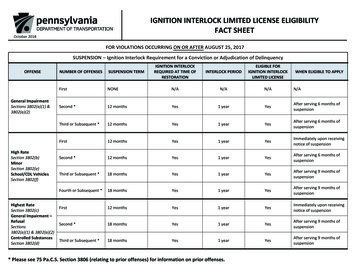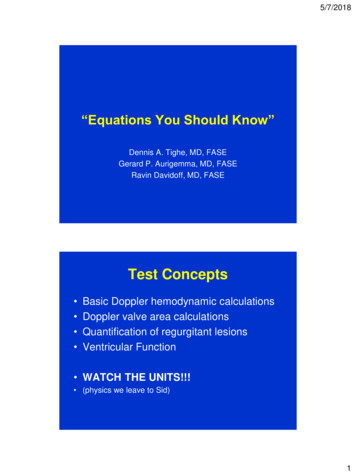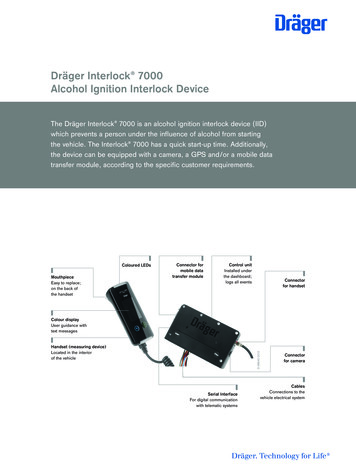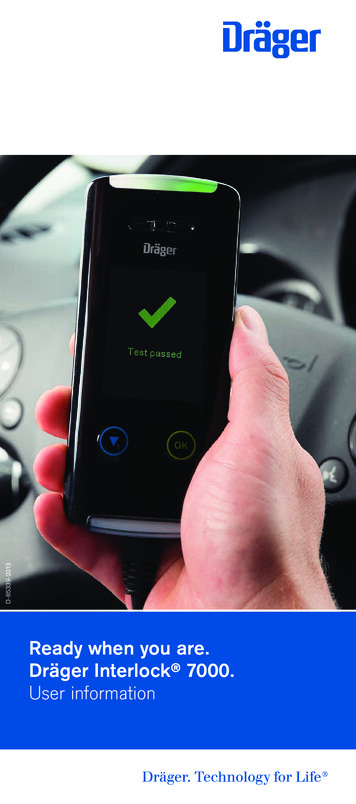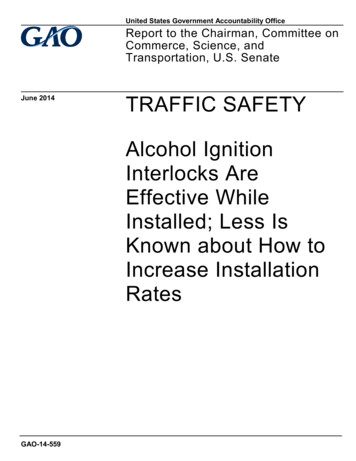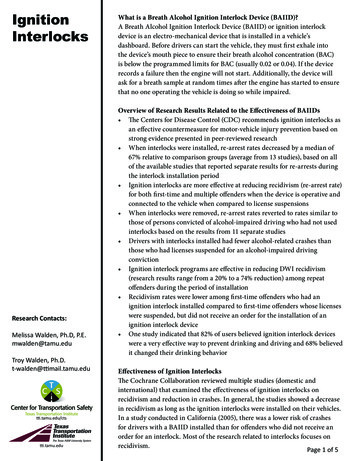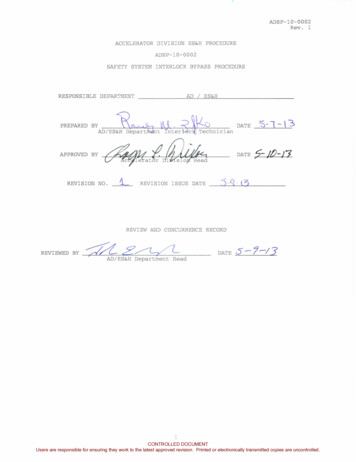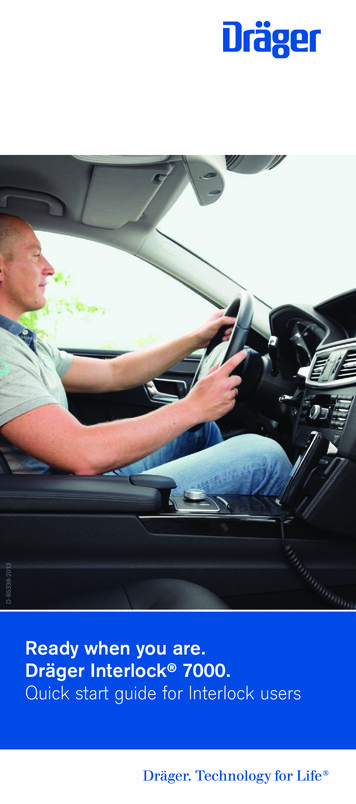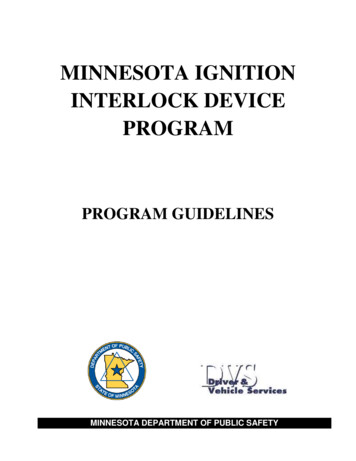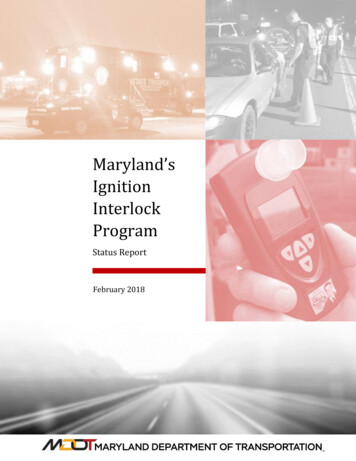
Transcription
Maryland’sIgnitionInterlockProgramStatus ReportnoahFebruary 2018
A Message from the GovernorDear Fellow Marylanders:Since the beginning of our administration, making Marylandsafer has been our top priority. Over the last three years, wehave made important progress in our fight to prevent impaireddriving. Ignition interlock remains one of our most importanttools to keep drunk drivers from getting behind the wheel andendangering themselves and others. With the implementationof Noah’s Law in October 2016, we now have more driversparticipating in Maryland’s Ignition Interlock Program thanever before.Still, too many Maryland families have been shattered and toomany lives have been cut short due to the reckless actions ofLarry Hoganan impaired driver. Each year in Maryland, on average, oneGovernorthird of all traffic fatalities involve an impaired driver. Meetingmany of those families at our annual Maryland Remembersevent inspired me to find more ways that we can work together to prevent this from happeningto another family.This status report provides an updated overview of impaired driving arrests and outlines howMaryland’s Ignition Interlock Program is working to protect the lives of everyone who travelsour streets and highways, helping us move toward our goal of having zero deaths on Maryland’sroadways.Working with Maryland law enforcement agencies, the Maryland court system, elected officials,and numerous local highway safety partners, we continue the fight to stop preventable deathscaused by drunk or drugged drivers. Together, we can change Maryland for the better.Sincerely,Larry HoganGovernorPage 1
IntroductionDrunk and drug-impaired drivers cause irreparable harm to individuals, families, and communities acrossMaryland. From 2012 to 2016, on average, there were more than 7,200 impaired driving crashes eachyear, resulting in nearly 3,500 injuries and 156 fatalities in Maryland. This loss of life representsapproximately one-third of all traffic fatalities in the state. To combat this problem, Maryland employs acomprehensive approach, defined in our Strategic Highway Safety Plan, that combines strict laws,license sanctions, a robust ignition interlock program, high-visibility law enforcement and outreach tothe public.Maryland’s Ignition Interlock Program is an effective tool to help prevent the devastating consequencesthat can result when an impaired driver decides to get behind the wheel. Research continues to showthat drivers who have ignition interlock devices installed are less likely to have a repeat drunk-drivingoffense while using ignition interlock than drunk drivers who do not have an interlock device installed.In Fiscal Year (FY) 2017, Maryland’s Ignition Interlock Program prevented more than 2,000 drivers fromstarting or operating a vehicle where the driver’s blood alcohol concentration1 (BAC) was greater than0.08 grams of alcohol per deciliter of blood (g/dL) – the legal limit in Maryland. Ignition interlockcontinues to save lives by preventing impaired drivers from driving on Maryland roads.The Drunk Driving Reduction Act of 2016, also known as Noah’s Law, took effect in Maryland on October1, 2016. Noah’s Law makes Maryland’s roadways safer by mandating ignition interlock for impaireddrivers who are convicted of certain impaired driving offenses, by increasing administrative driverlicensing sanctions and by making the requirements for completing assignments to the Ignition InterlockProgram more stringent. The implementation of Noah’s Law has resulted in increased participation inthe Ignition Interlock Program, particularly among drivers opting into the program for the first time.Impaired Driving in MarylandAn impaired driving arrest begins the process of evaluating, sanctioning, and monitoring drunk drivers.From 2012 to 2016, more than 113,000 impaired driving arrests were made in Maryland.Maryland’s impaired driving laws include driver licensing sanctions administered by the MarylandDepartment of Transportation Motor Vehicle Administration (MDOT MVA), and criminal sanctions thattake effect following conviction or probation before judgment disposition by a court for criminalimpaired driving offenses. The sanctions vary by chemical test result or refusal to submit to a chemicaltest, and whether the driver has committed prior impaired driving offenses.1Blood/Breath Alcohol Concentration (BAC) is the amount of alcohol in a breath or blood sample. BAC is expressedas the weight of ethanol, in grams, in 100 milliliters of blood, or 210 liters of breath.Page 2
Before a chemical test is administered to a suspected impaired driver, the arresting officer advises thedriver of their rights and advises them of the administrative sanctions that may result if their BAC isabove the legal limit or if they refuse to submit to the chemical test.A driver whose test results show a BAC that is 0.08 g/dL or higher is considered to be Driving Under theInfluence (DUI) by law, or per se. According to Maryland State Police summary report data, shown inTable 1, more than one-third of drivers arrested in 2016 refused to submit to a chemical test, more than80 percent of drivers tested had a BAC above the legal limit, and nearly 40 percent of drivers tested hada BAC of 0.15 g/dL or higher. If the driver’s BAC is below the legal limit for a per se violation, they maystill be charged with one or more impaired driving offenses, including driving while impaired (DWI), ifthere is other evidence of impairment. If convicted, drivers can face both criminal penalties, includingfines and incarceration, and additional administrative driver license sanctions, including licensesuspension or revocation.TABLE 1: IMPAIRED DRIVING ARREST ALCOHOL TESTING, CY 2012-2016Testing for §21-902 (a) and (b) Offenses20122013201420152016Drivers Offered Test21,23921,15120,51820,08919,326Drivers Tested14,36414,62413,95913,44012,661Drivers Refused Test6,8756,5276,5596,6496,665Refusal Rate32.4%30.9%32.0%33.1%34.5%Source: Compiled from Maryland State Police, Alcohol Influence and PBT Use Summary ReportsTABLE 2: BAC RESULTS OF DRIVERS TESTED BY PERCENT, CY 2012 - 2016BAC Level (g/dL) 0.02 g/dL0.02 - 0.04 g/dL0.05 - 0.07 g/dL0.08 - 0.14 g/dL0.15 or More .9%39.3%201610.7%2.5%6.2%41.6%39.0%Source: Compiled from Maryland State Police, Alcohol Influence and PBT Use Summary ReportsAdministrative SanctionsIf a driver refuses to submit to a chemical test, or tests above the legal limit, the arresting officer issuesthe driver an Order of Suspension for violating the terms of their licensure and sends a copy to MDOTMVA. On average, MDOT MVA receives approximately 20,000 Orders of Suspension each year. Table 3summarizes the numbers of Orders of Suspension received by MDOT MVA between 2012 and 2016, byoffense type and year.Page 3
TABLE 3: ORDERS OF SUSPENSION RECEIVED BY OFFENSE TYPE, CY 2012 - 2016Offense Type20122013First Offense6,962 6,804*Test RefusalSecond or1,721 1,665Subsequent OffenseFirst Offense5,349 5,5360.08 - 0.14 g/dLSecond orBAC959971Subsequent OffenseFirst Offense5,330 5,6010.15 g/dL BAC orSecond orHigher429527Subsequent OffenseTotal Orders of20,750 21,104Suspension ,362 19,887 19,130Source: MDOT MVA Document Imaging and Workflow System. *These test refusal figures represent allOrders of Suspension received by MDOT MVA from law enforcement agencies including, but not limited to,those reported to Maryland State Police, shown in Table 1;The total number of Orders of Suspensions received by MDOT MVA decreased from 20,750 in 2012 to19,130 in 2016. During this period, the number of Orders of Suspension issued for test refusalsremained relatively unchanged. By contrast, comparing 2012 to 2016, the number of Orders ofSuspension received for 0.08-0.14 g/dL BAC offenses and for first offenses for 0.15 g/dL or higher BACtest results decreased by approximately 14 percent.As shown in Table 4, Noah’s Law significantly increased license suspension periods for drivers who testedat or above 0.08 g/dL BAC or who refused the chemical test.TABLE 4: CHANGES IN LICENSE SANCTIONS FOR ADMINISTRATIVE PER SE VIOLATIONS UNDER NOAH'S LAW0.08 -0.14 g/dL BAC0.15 g/dL BAC or MoreTest RefusalOffenseFirstSecond or SubsequentPrior LawNoah's Law Prior LawNoah's LawPrior Law Noah's Law45 Days90 Days180 Days180 Days180 Days270 Days120 Days1 Year90 Days180 Days270 Days2 YearsFor violations occurring on or after October 1, 2016, the increased suspension periods provide additionalincentive for drivers to participate in the Ignition Interlock Program voluntarily. If eligible2, drivers mayimmediately opt-in to the Ignition Interlock Program rather than serve a longer driver license suspensionor request an administrative hearing.2Drivers whose licenses are suspended or revoked for other violations are not eligible to participate in the program.Page 4
A driver may request a hearing with the Office of Administrative Hearings (OAH) to contest the Order ofSuspension or seek an alternative to a license suspension. At an OAH hearing, the possible outcomesdepend on the nature of the offense. In cases where the driver had a BAC between 0.08 g/dL and 0.14g/dL, the Administrative Law Judge may modify the driver license suspension to allow the offender todrive to work, school, alcohol treatment, and medical appointments with no requirement to install anignition interlock device. Drivers who refused the chemical test or whose test result was 0.15 g/dL BACor higher at the time of the arrest are not eligible for this type of restrictive license. For these drivers,the only suspension modification that is normally available is participation in the Ignition InterlockProgram.Figures 1 and 2 illustrate changes in the disposition of two types of OAH administrative per se hearingsin fiscal years 2016 and 2017 before and after the implementation of Noah’s Law. In cases involving afirst 0.08 – 0.14 g/dL BAC test result (Figure 1), which have the lowest interlock referral rate among alltypes of administrative per se cases, the percentage resulting in a referral to the Ignition InterlockProgram increased more than twofold. The interlock referral rate also increased in cases involving a firsttest refusal (Figure 2), from at or below 40 percent before the implementation of the new law to morethan 50 percent after the law took effect.Figure 2: Percentage ofCustomers Referred to Interlock,OAH Cases Involving a First .0%30.0%FY16Q36.0%40.0%FY16Q28.0%50.0%FY16Q1% REFERRED TO INTERLOCK10.0%Noah’s Law60.0%FY17Q3Noah’s Law12.0%FY16Q1% REFERRED TO INTERLOCKFigure 1: Percentage of CustomersReferred to Interlock, OAH CasesInvolving a First 0.08-0.14BACTest ResultCitations and Court DispositionsIn the past five years, more than 309,000 impaired driving citations have been issued in Maryland.During one impaired driving arrest, an officer may issue citations under multiple sections of Maryland’simpaired driving law, in addition to citations for other moving violations. Table 5 shows the total numberof arrests and citations received by the District Court of Maryland from 2012 to 2016. Overall, impaireddriving arrests declined by approximately 13 percent and citations issued declined by approximately 15percent from 2012 to 2016.Page 5
TABLE 5: IMPAIRED DRIVING ARRESTS AND §21-902 CITATIONS, CY 2012 - 61,90054,040309,970Source: National Study Center for Trauma and Emergency Medical Systems at the University ofMaryland School of Medicine, based on District Court of Maryland Data. Includes updated 2015 data.All impaired driving citations are “must appear” offenses; the driver does not have the option to pay afine in lieu of appearing for a hearing in District Court. At a hearing, it is common for a driver to befound Guilty or receive a Probation Before Judgment (PBJ) for only one violation, while the othercitations issued at the time of arrest, including other impaired driving citations, are not prosecuted.To evaluate the outcome of a single arrest, the final disposition imposed for each citation issued arecategorized by the most severe outcome among citations issued: Guilty; PBJ, or Other (dispositions thatdo not result in criminal or administrative sanctions, such as Not Guilty and Nolle Prosequi). Figure 3illustrates case outcomes for all Transportation Article (TR) §21-902 Offenses with a disposition from2012 through 2016.FIGURE 3: PERCENTAGE OF GUILTY, PROBATION BEFORE JUDGMENT, AND OTHER DISPOSITIONS IN MARYLAND FOR ALLTR §21-902 OFFENSES COMBINED BY YEAR, CY 5.9%47.4%29.0%28.3%26.7%25.7%25.7%GuiltyPBJOther DispositionSource: National Study Center for Trauma and Emergency Medical Systems at the University ofMaryland School of Medicine, based on District Court of Maryland Data. Includes updated 2015 data.Table 6 shows case outcomes from 2012 to 2016 for each type of §21-902 violation by year.Page 6
T ABLE 6: I MPAIRED D RIVING C ITATION D ISPOSITIONS BY O FFENSE T YPE AND Y EAR , CY 2012-201620122013201420152016§21-902(a) Driving Under the Influence of 94,4422,2974,410Other Disposition4,5454,3454,6054,7364,057§21-902(b) Driving While Impaired by AlcoholGuiltyPBJOther 02,3954,624611756851581482§21-902(c) Driving While Impaired by Drugs or Drugs and r Disposition490500513526588§21-902(d) Driving While Impaired by Controlled Dangerous SubstanceGuiltyPBJ12097144102978011067130105Other Disposition180201225223219Source: National Study Center for Trauma and Emergency Medical Systems at theUniversity of Maryland School of Medicine, based on District Court of Maryland Data.Includes updated 2015 data.Sanctions after ConvictionDrivers face both criminal sanctions, including fines and incarceration, and additional administrativelicensing sanctions for convictions of impaired driving. Prior to October 1, 2016, only drivers convictedof a TR §21-902(a) violation within five years of a TR §21-902(a) or (d) violation were mandated toparticipate in the Ignition Interlock Program. Also, prior to October 1, 2016, drivers convicted of TR §21902(a) with a high BAC and drivers convicted of TR §21-902(a) while under the age of 21 could only havetheir license suspensions modified if they agreed to participation in the Ignition Interlock Program.New Mandates for Interlock under Noah’s LawNoah’s Law expanded the mandates requiring participation in the Ignition Interlock Program forMaryland to include all drivers convicted of TR §21-902(a). It also mandates participation in theprogram for conviction for TR §21-902(b) and (c) violations, if the offense involved certain conditions,such as having refused the chemical test or while transporting a minor under the age of 16. IgnitionInterlock Program participation is now also required for drivers who are convicted of homicide or lifethreatening injury by motor vehicle while DUI or DWI. The law also mandates participation in theprogram for Maryland drivers convicted in other states of equivalent charges.Drivers that are required to participate in the Ignition Interlock Program must successfully complete aprogram referral before becoming eligible for a non-interlock-restricted license. Drivers mustparticipate in the program for a duration of six months if it is the first time the driver’s participation isPage 7
mandated. Referral lengths increase if the driver is required to participate in the program for asubsequent violation: one year for the second mandatory referral and three years for the thirdmandatory referral.Maryland’s Ignition Interlock ProgramMaryland’s Ignition Interlock Program, established in 1989 and managed by MDOT MVA, providesMaryland drivers with an alternative to license suspension or revocation and allows them to continuedriving while reducing the likelihood they will drive impaired. Ignition interlock devices connect a motorvehicle's ignition system to a breath analyzer that measures a driver's breath alcohol level. The drivermust blow into a mouthpiece connected to the device, allowing the device to capture a breath sampleand calculate the driver’s BAC. If a device detects a BAC greater than 0.025 g/dL, it will prevent thevehicle from starting. After a driver has passed this initial test and the car has been started, randomrolling retests are required to be certain the driver has not consumed alcohol.Ignition interlock devices installed in participants’ vehicles store the results of breath tests and otherdata which is downloaded by the ignition interlock service provider when the driver brings the vehicle infor monthly service and calibration. MDOT MVA’s computer systems review the data and identifiespossible violations for the Ignition Interlock Program staff to review and take appropriate action. Thisautomated process allows MDOT MVA to efficiently monitor participants and provide ongoing feedbackto program violators.Ignition interlock devices incorporate safeguards against circumvention of starting and retestingprocedures. Attempts to bypass the device are recorded and marked as violations. One concern thathas been raised about the program is that participants may attempt to start their interlock-equippedvehicle by having another person supply the required breath sample. To eliminate this possibility,MDOT MVA has worked with Maryland ignition interlock vendors to offer devices with integrated digitalcameras. These devices store a digital image each time a breath sample is taken; these images areavailable for retrieval to confirm that the participant provided the required breath sample. Cameraequipped interlock devices are a valuable tool to prevent and investigate testing fraud and sanctionviolators.Currently, there are seven service providers authorized to install and monitor ignition interlock devicesin Maryland. All service providers must install a device for eligible participants within 10 days of arequest and provide a toll-free 24-hour emergency response number for participants. The cost to installan ignition interlock device ranges from 150 to 200, depending on the provider. Average cost formonthly monitoring ranges from 65 to 90; these costs are comparable to fees charged by providers inother states.Program ParticipationMaryland’s Ignition Interlock Program monitors thousands of participating drivers each year. The totalnumber of drivers in the program fluctuates daily, as new drivers enter the program and otherscomplete the program or are removed for noncompliance. To provide a consistent measure of programparticipation, the numbers of unique drivers with one or more active Ignition Interlock Program referralsPage 8
are tracked on a quarterly as well as annual basis, as shown in Table 7. It is significant to note that thepercentage of drivers in the program increased 10 percent from FY 2016 to FY 2017, primarily due to theimplementation of Noah’s Law.TABLE 7: INTERLOCK PROGRAM PARTICIPATION, FY2016-2017Prior LawFY2016FY2017% ChangeNoah’s LawQ1Q2Q3Q4All of Fiscal Year(Jul-Sep) (Oct-Dec) (Jan-Mar) 10,88911,80216,289-2% 2% 10% 17% 10%Source: MDOT MVA Document Imaging and Workflow SystemProgram Referral SourcesIndividuals are referred to the Ignition Interlock Program for a range of reasons – for administrative perse violations, as a result of an impaired driving conviction, or as a requirement of the reinstatement ofdriving privileges. Many drivers are referred to the program by more than one source, and it is commonfor drivers to have multiple referrals that are active at the same time. For example, a driver can have anactive referral after opting into the program for an administrative per se offense and have anotheractive referral arising from a conviction arising from the same incident.Administrative Per Se Program ReferralsA major change under Noah’s law was the significant strengthening of administrative suspensions forper se violations, making participating in the Ignition Interlock Program a more attractive alternative toserving a longer suspension period. Sanctions for per se violations take effect on the 46th day after thedate of violation, unless the customer requests a hearing or opts into the Ignition Interlock Program. Bycontrast, on average, convictions for impaired driving offenses occur more than 200 days after arrest.Customers that opt in for a per se violation typically enter the program significantly sooner than if theyenter only after a conviction.Evaluating how customers first enter the Ignition Interlock Program provides insight into how changesunder Noah’s Law influence their decision to participate in the program and when. In FY 2017, 6,579drivers participated in the Ignition Interlock Program for the first time, up from 5,137 in FY 2016, anincrease of more than 25 percent.Figure 4 shows the levels of first-time participation, comparing per se referrals to referrals from all othersources (e.g. court referral or requirement of reinstatement) from FY 2012 to FY 2017. The number offirst-time Ignition Interlock Program customers entered with a per se referral increased nearly 40percent in FY 2017 over FY 2016 levels. The greatest increase during FY 2017 occurred after theimplementation of Noah’s Law.Page 9
FIGURE 4: REFERRAL SOURCE OF NEW PARTICIPANTS BY FISCAL QUARTER, FY 2012 - FY 201716001400120010008006004002000Noah’s LawPer Se as First ReferralAll Other Sources as First ReferralSource: MDOT MVA Document Imaging and Workflow SystemThe increase in first-time per se referrals coincides with an overall increase in Ignition Interlock Programparticipation. The total number of program participants increased by 10 percent in FY 2017 to 16,289,up from 14,816 in FY 2016. These increases in participation occur during a period when the totalnumber of Orders of Suspension received by MDOT MVA decreased, from 19,887 in FY 2016 to 19,130 inFY 2017.Post-Conviction Program ReferralsIn addition to the increase in administrative per se sanctions, Noah’s Law expanded the mandates forprogram participation by convicted drunk drivers. The number of Ignition Interlock Program referralsletters sent to customers convicted of DUI doubled in the second half of FY 2017 following theimplementation of Noah’s Law.Length of ParticipationFigure 5 shows the length of time participants were enrolled in the Ignition Interlock Program. Morethan half of the participants spent one year or less in the program. Forty-four percent of drivers wereeither assigned to the program for more than one year, or had their original assignment periodextended beyond one year due to program violations or subsequent impaired driving offenses. Repeatoffenders can be referred to the Ignition Interlock Program for terms of up to three years.FIGURE 5: LENGTH OF COMPLETED IGNITION INTERLOCK ASSIGNMENTS, CY 2012 - 2016Source: MDOT MVA Document Imaging and Workflow SystemPage 10
Participant DemographicsMore than half of the individuals who participated in the Ignition Interlock Program were between theages of 21 and 39 and more than 90 percent of program participants were under the age of 60. Amongall age categories, most participants were male. Individuals who are arrested and enrolled in theIgnition Interlock Program are more likely to be 30 years of age or older, compared to drivers who werearrested but who did not enroll in the program.FIGURES 6: AGE OF INTERLOCK PARTICIPANTS, FY 2017Source: MDOT MVA Document Imaging and Workflow System and Mainframe dataFigure 7 shows the jurisidiction of residence of Ignition Interlock Program participants. More than 50percent of the participants in the program in FY 2017 resided in four counties: Anne Arundel, Baltimore,Montgomery, and Prince George’s.FIGURE 7: JURISDICTION OF RESIDENCE FOR IGNITION INTERLOCK PROGRAM PARTICIPANTS, FY 201718%Percentage of All Participants16%14%12%10%8%6%4%2%0%Source: MDOT MVA Document Imaging and Workflow SystemPage 11
Participation RequirementsOnce enrolled in the Ignition Interlock Program, drivers are required to report to their service providerevery 30 days to have the ignition interlock device calibrated and so that data captured from the devicecan be downloaded. Failure to report for calibration and service, as required, can result in removal fromthe program and suspension of the driver’s license.Violations of the Ignition Interlock Program rules and requirements include, but are not limited to thefollowing: Failure to have the ignition interlock device installed and obtain a Maryland driver’slicense restricted to the operation of vehicles equipped with an ignition interlockdevice; Failure to appear for the required monthly monitoring visit; Operating a motor vehicle not equipped with a functioning ignition interlock deviceapproved for use in the program; Failure to abide by the terms and conditions of the service agreement with the ignitioninterlock service provider, including payment of all costs and fees associated with theprogram; Tampering with, bypassing, or otherwise removing or rendering inoperable the ignitioninterlock device, or allowing someone else to do the same; Attempting to start or operate the vehicle with BAC greater than 0.025 g/dL; Failure to submit to retests after starting the car; and Any license suspension or revocation imposed while participating in the program.Consequences of Program ViolationsEach time a driver has one or more violations during a monitoring period, after review by IgnitionInterlock Program staff, they are notified and their participation period is extended by one month. Ifthere is a fourth monitoring period with a violation, the driver is removed from the program and theoriginal licensing sanction is imposed.In FY 2017 1,293 drivers were removed from the Ignition Interlock Program for noncompliance. If adriver is removed from the program, they may re-enter the program for the duration initially assignedafter a minimum suspension period of 30 days. In FY 2017, 478 drivers re-entered the program afterhaving been removed for noncompliance.The Ignition Interlock Program continues to stop customers from driving after consuming alcohol. In FY2017, more than 7,000 drivers had ignition interlock violations where the breath sample was collectedand the value was greater than 0.025 g/dL BAC, and more than 2,000 ignition drivers had violationswhere a breath sample was collected and the value was greater than 0.08 g/dL BAC. Each of theseviolations represents an individual attempting to drive after consuming alcohol and the ignition interlockdevice prevented the driver from starting or continuing to operate the vehicle.Page 12
Completing the ProgramUnder Noah’s Law, a participant is considered to have successfully completed the program when MDOTMVA receives certification from the service provider that there were no violations in the final threemonths of their assignment. To successfully complete the program, participants may not have any of thefollowing violations in the three months prior to completion: An attempt to start the vehicle with a BAC of 0.04 g/dL or more unless a subsequent test isperformed within 10 minutes that registers a BAC lower than 0.04 g/dL; Failure to take or pass a random test with a BAC of 0.025 g/dL or lower unless a subsequentretest performed within 10 minutes registers a BAC lower than 0.025 g/dL; or Failure to appear at the approved service provider when required for maintenance, repair,calibration monitoring, inspection or replacement of the device causing the device to cease tofunction.Any violations meeting these criteria in the last three months of an assignment extends the participationend date to three months from the date of the violation.Once the driver has successfully completed the required participation period, including any extensions,the driver must bring their vehicle to their ignition interlock service center for a final data download. Ifno violations are noted, MDOT MVA mails a letter of successful completion to the driver. The driver cantake this completion letter to any MDOT MVA branch office to receiving a new, unrestricted license; thedriver can then have the ignition interlock device removed from their vehicle.In FY 2017, 4,307 drivers successfully completed their assignments to the program.Credit for Successful CompletionUnder the provisions of Noah’s Law, a driver can receive credit for successful participation in the IgnitionInterlock Program for an administrative per se offense. If the driver is subsequently convicted of animpaired driving offense and, as a result, is required to participate in the Ignition Interlock Program, thedriver receives credit for participation for the administrative per se offense, if they successfullycompleted their referral. This offers additional incentive for drivers to voluntarily participate in lieu ofserving an administrative per se suspension. More than 1,200 Interlock customers have received creditfor successful per se participation.Post-Interlock OutcomesTable 9 identifies the type and frequency of citations that were issued to Ignition Interlock Programparticipants (enrolled 2011 to 2016) after their exit from the program, either upon successfulcompletion or for removal for noncompliance. The most common violations were for impaired driving,speeding and driving while suspended or revoked.Page 13
TABLE 9: MOST COMMON CITATIONS ISSUED AFTER EXITING THE IGNITION INTERLOCK PROGRAM (ENROLLEES FROMCY2011-2016)Number of Citations
first 0.08 - 0.14 g/dL BAC test result (Figure 1), which have the lowest interlock referral rate among all types of administrative per se cases, the percentage resulting in a referral to the Ignition Interlock Program increased more than twofold. The interlock referral rate also increased in cases involving a first
